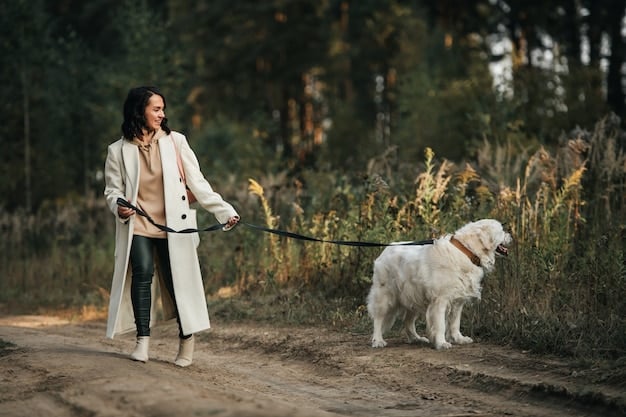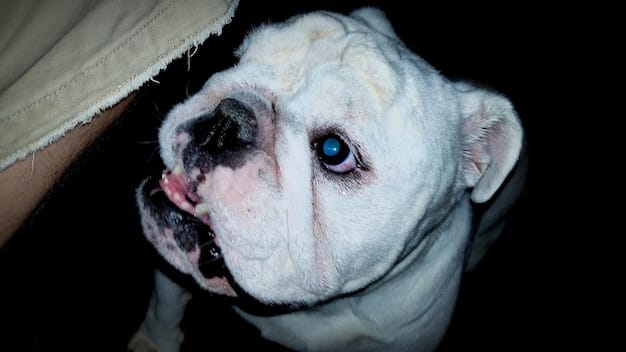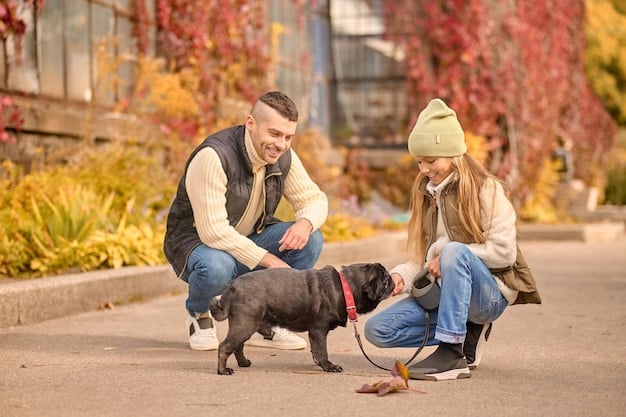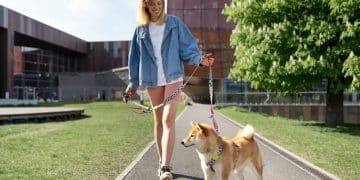Leash Reactivity SOS: Calm Your Dog Now!

Anúncios
Leash reactivity in dogs can turn walks into stressful events, but a consistent 15-minute daily drill focusing on focus, impulse control, and positive reinforcement can significantly calm your dog and improve their behavior on walks.
Is your dog turning into a barking, lunging mess the moment the leash goes on? Leash reactivity SOS: Calm your dog on walks with this 15-minute daily drill designed to transform chaotic outings into peaceful strolls.
Anúncios
Understanding Leash Reactivity in Dogs
Leash reactivity isn’t just bad behavior; it’s often a sign of underlying anxiety, frustration, or fear. Recognizing the root cause is the first step toward helping your dog.
What Causes Leash Reactivity?
Numerous factors can contribute to leash reactivity. It’s essential to identify what triggers your dog to tailor your training approach effectively.
Anúncios
- Fear: Dogs might react defensively if they feel threatened by other dogs, people, or objects.
- Frustration: Some dogs are excited to greet others but become frustrated when the leash restricts them.
- Territoriality: The leash can amplify a dog’s protective instincts, leading to reactive behavior.
- Poor Socialization: Inadequate exposure to various stimuli during puppyhood can result in fear or aggression later in life.
Understanding the specific triggers for your dog will guide your training and management strategies. Look for patterns in their behavior, noting what sets them off—other dogs, bikes, children, etc.

Remember, leash reactivity is a complex issue with multiple potential causes. Patience, consistency, and a positive, understanding approach will yield the best results.
The 15-Minute Daily Drill: A Step-by-Step Guide
This 15-minute daily drill provides a structured approach to addressing leash reactivity. Consistency is key to achieving lasting results. Focus on creating a positive and rewarding experience for your dog.
Phase 1: Focus Training (5 minutes)
Start by teaching your dog to focus on you, even in distracting environments. This sets the foundation for better impulse control on walks.
- “Watch Me” Command: Hold a treat near your eyes and say “watch me.” When your dog makes eye contact, reward them immediately.
- Duration Training: Gradually increase the duration of eye contact before rewarding.
- Distraction Introduction: Practice the “watch me” command in progressively more distracting environments.
Remember to keep training sessions short, fun, and positive. End each session on a successful note, reinforcing good behavior.
Phase 2: Impulse Control (5 minutes)
Impulse control exercises help your dog learn to manage their reactions and make better choices when faced with triggers.
“Leave It” Exercise
Teach your dog to ignore tempting stimuli by using the “leave it” command.
- Initial Setup: Place a treat on the floor and cover it with your hand.
- Command and Response: Say “leave it.” If your dog tries to get the treat, keep your hand firmly in place.
- Reward Compliance: Once your dog stops trying to get the treat, reward them with a different, higher-value treat.
Gradually introduce the “leave it” command in different settings, using various objects to increase the challenge.
“Stay” Exercise
Practice the “stay” command to improve your dog’s ability to remain calm and controlled.
- Start Simple: Have your dog sit or lie down, then say “stay.”
- Gradual Increase: Slowly increase the duration and distance of the “stay.”
- Add Distractions: Introduce mild distractions, such as walking around your dog, while they are in the “stay” position.
These exercises are designed to enhance your dog’s ability to manage impulses, making them less likely to react strongly to triggers on walks.

Phase 3: Leash Manners (5 minutes)
This phase focuses on practicing good leash manners in a controlled environment before venturing out into more challenging situations.
Loose-Leash Walking
Teach your dog to walk politely on a loose leash without pulling or lunging.
- Start Indoors: Practice loose-leash walking indoors, using treats to reward your dog for staying close to you.
- Gradual Progression: Move to your backyard or a quiet outdoor space, gradually increasing the length of your walks.
- Redirection Technique: If your dog starts to pull, stop walking and gently redirect their attention back to you.
Consistent practice of these exercises will help your dog develop better leash manners, making walks more enjoyable for both of you.
Managing Triggers on Walks: Strategies and Tips
Even with consistent training, you’ll still encounter triggers on walks. Having strategies in place will help you manage these situations effectively.
Distance Management
Maintaining a safe distance from triggers is crucial for preventing reactive behavior.
Redirection Techniques
Use redirection techniques to divert your dog’s attention away from triggers.
- High-Value Treats: Carry high-value treats to distract your dog when you spot a trigger.
- Favorite Toys: Use a favorite toy to engage your dog and shift their focus.
Positive Reinforcement
Reward your dog for calm behavior in the presence of triggers.
- Calm Praise: Offer calm praise and treats when your dog remains calm and focused on you.
- Avoid Punishment: Never punish your dog for reacting, as this can increase their anxiety and worsen the behavior.
Successfully managing triggers requires patience, observation, and a proactive approach. Adjust your strategy as needed, based on your dog’s individual needs and responses.
Advanced Techniques for Leash Reactivity
Once your dog has mastered the basics, you can introduce more advanced training techniques to further improve their behavior on walks.
Counter-Conditioning and Desensitization
Counter-conditioning and desensitization involve changing your dog’s emotional response to triggers.
- Desensitization: Gradually expose your dog to triggers at a low intensity, ensuring they remain calm and comfortable.
- Counter-Conditioning: Pair the presence of the trigger with something positive, such as a high-value treat.
Seeking Professional Help
If you’re struggling to manage your dog’s leash reactivity on your own, consider seeking help from a professional dog trainer or behaviorist. They can provide personalized guidance and support.
Leash reactivity can be a frustrating and challenging issue, but with the right approach, you can significantly improve your dog’s behavior and enjoy stress-free walks.
| Key Point | Brief Description |
|---|---|
| 🐶 Focus Training | Teaches your dog to concentrate on you, crucial for managing distractions. |
| 🐾 Impulse Control | Helps your dog control reactions, using “Leave it” and “Stay” commands. |
| 🚶 Loose-Leash Walking | Trains your dog to walk calmly without pulling, starting indoors. |
| 🛑 Managing Triggers | Strategies to handle triggers on walks, including distance and redirection. |
Frequently Asked Questions
▼
Leash reactivity refers to a dog’s exaggerated responses, like barking or lunging, when on a leash. This often stems from frustration, fear, or excitement triggered by other dogs, people, or stimuli while restrained.
▼
Results vary depending on the dog’s temperament and consistency of training. Some may show improvement within a few weeks, while others might take several months. Consistency and positive reinforcement are key.
▼
If the daily drill isn’t effective, re-evaluate your approach. Consider seeking guidance from a professional dog trainer or behaviorist who can provide tailored advice and address underlying issues.
▼
No, punishment is not recommended. It can increase anxiety and fear, worsening reactivity. Positive reinforcement methods, like rewarding calm behavior and redirection, are more effective and humane.
▼
High-value treats are irresistible to your dog, such as small pieces of cooked chicken, cheese, or hot dogs. These are reserved for training to motivate and reward desired behaviors effectively during challenging situations.
Conclusion
Tackling leash reactivity requires patience, understanding, and consistent effort. By implementing the 15-minute daily drill and managing triggers effectively, you can significantly improve your dog’s behavior on walks, transforming stressful outings into enjoyable experiences for both of you.






